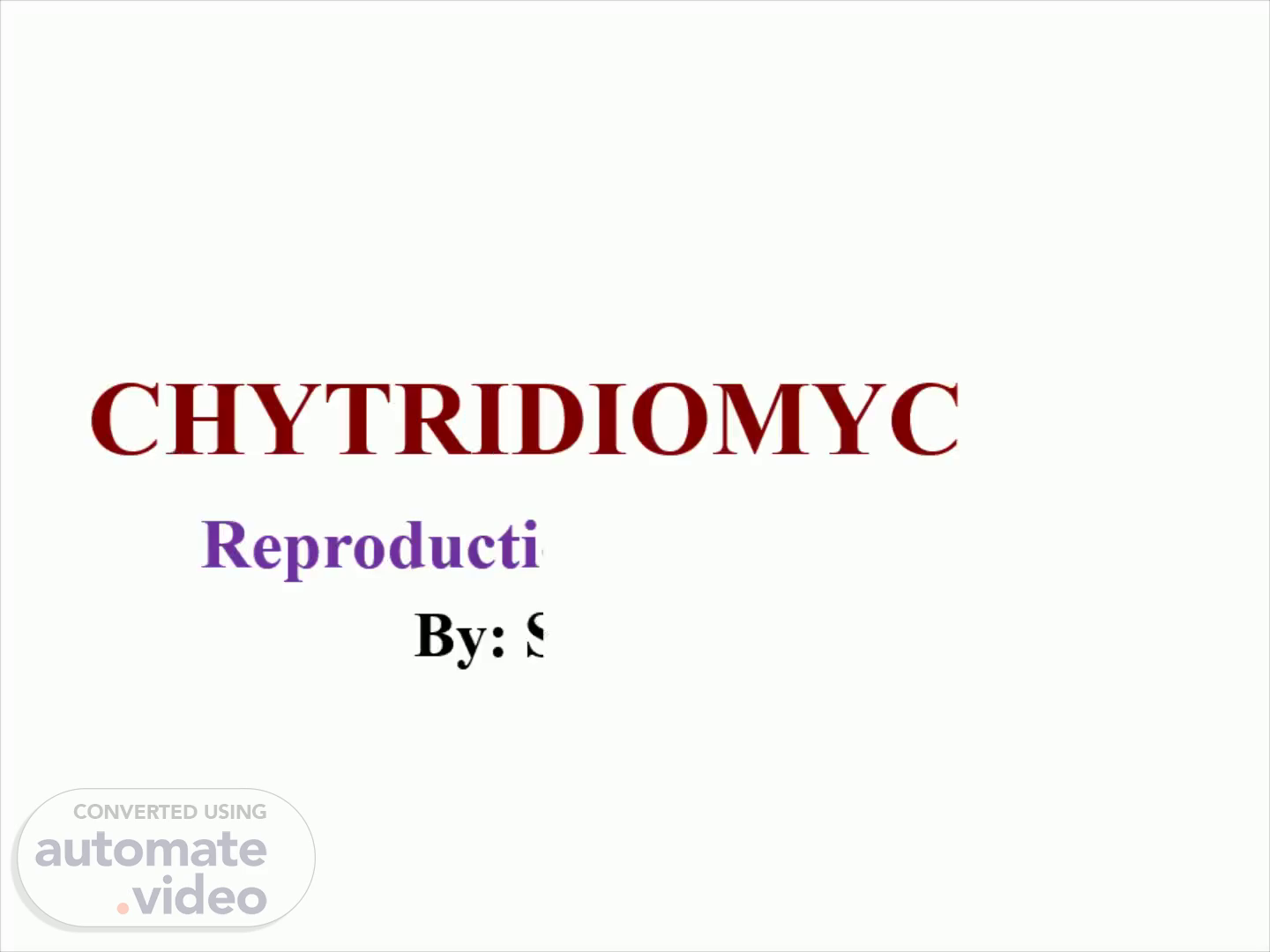Scene 1 (0s)
CHYTRIDIOMYCOTA. Reproduction and Life Cycle By: S.T Botanist.
Scene 2 (7s)
INTRODUCTION. Ch ytridiomycota is a division of fungi which include organisms that involves the formation of zoo spores. They referred as chytrids . The name is derived from Greek word Chytridion meaning " little pot" ( used to describe the structure which contains zoospores ) . There are 100 genera including 1000 species ..
Scene 3 (23s)
CLASSIFICATION. Kingdom Fungi Sub kingdom Eumycota Division Chytridiomycota Class Chytridiomycetes.
Scene 4 (31s)
HABITAT. They are found in both aquatic and soil habitats. Some are anaerobic species, out of which some exist in the guts of herbivores. Chytridiomycota includes marine and freshwater species..
Scene 5 (44s)
CHARACTERISTICS. The species are microscopic in size. Some species are unicellular while few are multicellular. T hey produce zoospores .Zoospores have single whiplash flagellum. Cell wall is made up of chitin . Hyphae are coenocytic .There is no distinction between the cells. T hey are single celled organisms. They have branching hyphae along with rhizoids..
Scene 6 (1m 1s)
The plant body : It shows limited hyphal growth. They are heterotrophic . Some chytrids are holocarpic . It means that chitrids produce zoosporangium and zoospores. So me chytrids are eucarpic .They produce other structure e.g. rhizoids. So me are monocentric ( thallus bearing one zoosporangium ) while others are polycentric ( rhizoids bearing multiple zoosporangium )..
Scene 7 (1m 19s)
. Types of thallus •piblotk endoblotk.
Scene 8 (1m 25s)
REPRODUCTION. Chytridiomycota involves the formation of motile cells in their life cycle. They reproduce by sexual and asexual means. During asexual reproduction zoospores are formed which are diploid. The asexual spores are called diploid zoospores. Sexual Reproduction involves the formation of gametes . There are two types of reproduction : 1. Asexual Reproduction 2. Se xual Reproduction.
Scene 9 (1m 43s)
Asexual Reproduction. Chytrids reproduce by the formation of zoospores . zoospores starts swimming and finally they locate a suitable substratum . The zoospores attaches to it's host . It takes nutrients from it's host. It feeds on its host as a res ult it grows..
Scene 10 (1m 58s)
It undergoes meiotic cell divisions . As a result cell wall develops around the original zoospore. P rotoplasm increases in size and it will undergoes cleavage which results in the formation of zoospore s. Zoospores are liberated through a pore called operculum . On germination zoospores develops into the sporophyte ..
Scene 11 (2m 13s)
Sexual Reproduction. Sometimes sexual reproduction may occur via union of isogametes. Isogametes have same size and shape. Some algal parasites involves oogamy in which male gamete is mobile. It attaches with female gamete containing structurs ..
Scene 12 (2m 27s)
S exual Reproduction is may be isogamous anisogamous or oogamous . Alternation of generation is also found in the life cycle of some individuals. T he haploid thallus is called gametothallus .It produces male and female gametes. The colour of Male gametes is orange. They are smaller in size. Female gametes are colorless and larger than male gametes ..
Scene 13 (2m 45s)
Males are attracted to females when they produce the hormone sirenin . Females are attracted to males when they produce the hormone parisin . Th e sporothallus is diploid. It produces two types of sporangia; meitosporangium ( zoosporangium ) and meiosporangium ( resistant sporangium ). Meitosporangium produce diploid zoospores (2n) which play role in asexual reproduction while meiosporangium produce haploid zoospores following meiosis..
Scene 14 (3m 2s)
Meiosis Sexual resistant sporangia Asexual thin-walled sporangia Mature sporophyte Germinating resistant sgx»rangium Zoospores Qrminating Young Haploid (n) Zygote Germinating haploid zoospore Young gametophyte Mature gametophyte (n) gametangium Female gametes (n) gametes (n) Male gametangium Fertilization.
Scene 15 (3m 9s)
References. ht tps :// bio.libretexts.org /Bookshelves/ Introductory_and_General_Biology /Book%3A_General_Biology_(Boundless)/24%3A_Fungi/24.3%3A_Classifications_of_Fungi/24.3A%3A_Chytridiomycota%3A_The_Chytrids h ttps :// www.sciencedirect.com /topics/agricultural-and-biological-sciences/ chytridiomycota Alexopoulos CJ, Mims CW, Blackwell M. 1996. Introductory Mycology. 4th edition. John Wiley & Sons, Inc.
Scene 16 (3m 28s)
Annis SL, Dastoor FP, Ziel H, Daszak P, Longcore JE. "A DNA-based assay identifies Batrachochytrium dendrobatidis in amphibians." Journal of wildlife diseases. 2004 Jul;40(3):420-8 ..
